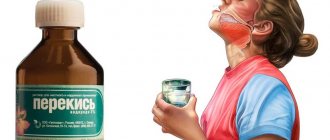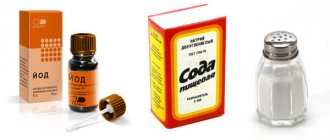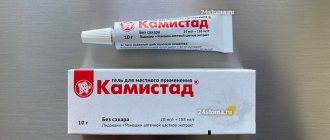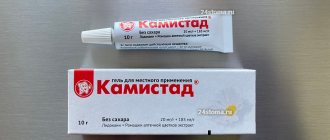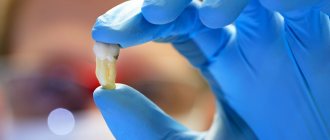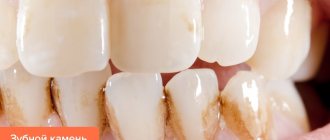Antibacterial compounds play an important role in maintaining oral hygiene. They are necessary to destroy bacteria and reduce pain. A solution of soda, salt and iodine is by far the safest and most affordable means of preventing many dental diseases. Rinsing helps to cope with aching, acute pain, and in some cases even relieve swelling near the gum pocket.
Sodium bicarbonate has many positive properties. Its use prevents the development of carious manifestations and inhibits pathological processes. You can even remove tartar using baking soda powder. Quite often they rinse their mouth with soda after resection of an element of the dentition has been performed or nerve endings have been painfully removed. Antibacterial compounds accelerate the regeneration of soft tissues and have a disinfecting effect.
What are the benefits of soda-salt solution for mouth rinsing?
The product is widely used for rinsing during the treatment of diseases of the teeth and gums: caries, gingivitis, periodontitis and periodontal disease. The solution helps out in cases where acute symptoms arise suddenly and you need to alleviate the condition before visiting the dentist. The soda-salt composition perfectly relieves inflammation and redness of the mucous membrane, disinfects, has a calming effect and helps to slightly reduce pain.
Sodium bicarbonate or simply soda is a product that is used to clean dirty surfaces, for example, in the kitchen. But a solution with its addition also helps in the treatment of many dental diseases. In combination with salt and sometimes with iodine, soda gives a pronounced antibacterial effect, strengthens hard and soft tissues, and prevents the further spread of the pathological process. Thus, the effect of the composition can be formulated in several main theses:
- has an antibacterial effect,
- helps stop the pathological process and prevents further destruction of the enamel,
- stops inflammatory processes in the mucous membrane,
- helps to significantly reduce pain and alleviate the condition,
- removes bacterial plaque and tartar.
Soda-saline solution helps in the treatment of many dental diseases.
Soda-saline solution is not suitable for daily use. It is recommended in cases where there are clear signs of pathological processes in the oral cavity. The composition can be used for emergency relief of acute symptoms, and as a maintenance agent - only after agreement with the attending physician.
Periodontal disease is a degenerative process of periodontal tissue due to deterioration of blood supply
The reason for the development of periodontal disease is a lack of blood supply to the periodontium, sometimes combined with cardiovascular and endocrine diseases. Blood delivers nutrients to all organs, therefore, with a lack of blood supply, the process of tissue degeneration begins.
with periodontal disease, bone decreases throughout the entire jaw, in contrast to periodontitis, which can also be local in nature
Periodontal disease develops very slowly and causes almost no trouble. The gums are pale, tightly cover the teeth and do not bleed; over time, the roots gradually become exposed, but the teeth can remain stable for quite a long time. Teeth are rarely affected by caries, and non-carious lesions (wedge-shaped defects and enamel erosion) are more common.
Indications for use
It is better to use the composition for rinsing on the recommendation of a specialist - the treating dentist. The main indications for use are listed below:
- heavy plaque, supra- and subgingival deposits, unpleasant odor: the composition effectively fights bacteria in the oral cavity, dissolves hardening deposits and prevents the growth of pathogenic microflora. In addition, the active ingredients have a beneficial effect on the enamel and help strengthen it, and by cleaning surfaces from bacteria and their metabolic products, breath is freshened,
- severe toothache: it is not possible to cure the problem with just rinsing, but it is quite possible to significantly reduce the intensity of acute symptoms. The product will help normalize the condition so you can safely get to the doctor,
- after tooth extraction: preventive rinsing with a soda-salt solution will help fight bacteria, prevent wound infection, help stop bleeding and stimulate healing processes. You just need to rinse carefully so as not to damage the blood clot in the hole,
- diseases of the teeth and gums: rinsing with salt and soda is recommended, among other things, as maintenance therapy during the treatment of caries, gingivitis, periodontitis and periodontal disease, periodontitis and periostitis with purulent processes - according to indications and only in concentrations recommended by a specialist.
Rinsing helps in the treatment of inflammation of the gums and dental plaque.
If there are microtraumas or cuts in the mouth, which may appear, for example, due to braces or incorrectly installed fillings, crowns and dentures, then such a solution will help to effectively disinfect tissues, and its regular use will help their rapid healing.
Why salt?
A salt solution was used against tooth pain and gum inflammation back in the days of Stepan Razin. In Rus', they did not know a more effective means of quickly eliminating toothache. Surprisingly, this white powder not only eliminates unpleasant symptoms, but also gives you good health for a long time.
In addition, the salt solution helps reduce tissue inflammation by “pulling” fluid from the inflamed area. Once in the mouth, the salt begins to absorb all the pathogenic bacteria from the gums, the solution penetrates even the narrowest crevices, holes and cracks in the tooth enamel. In addition, the saline solution quickly flushes away food debris, which often causes inflammation.
Back in the 17th century, Anthony van Leeuwenhoek discovered the unique disinfecting characteristics of salt: the scientist measured the number of microbes in a scraping of the oral cavity and realized that rinsing with salt would help prevent many infections and diseases in this area.
- Sodium chloride salt draws liquid from the affected area, and therefore prevents bacteria from multiplying.
- Salt disinfects tissues, washes away harmful microorganisms, disinfecting even the most inaccessible areas.
- The salt solution contains a huge amount of useful microelements.
- Salt does not cause allergies and has no side effects even if the solution is carelessly swallowed.
When is it better to avoid rinsing - contraindications
If the recommended dosages are observed, the medicinal solution is completely harmless and safe. But in some pathological conditions and individual intolerance to its components, the use of the product is strictly contraindicated.
So, it is better not to add soda to the composition if a small child is going to rinse the mouth. Under the age of 3-4 years, a child can easily accidentally swallow the concentrated composition, and this is fraught with stomach problems. It is better to soak a cotton swab or a small piece of gauze in the solution, and then apply it to the sore spot for just a few minutes.
Do not use the rinse solution for children under 3-4 years of age.
You should not rinse your mouth with salt and soda if you have a traumatic brain injury, brain disease, or a predisposition to a stroke. In case of thyroid dysfunction, tuberculosis and nephritis, iodine1 should not be added to the main composition. The same applies to women during pregnancy and breastfeeding. Do not rinse too often if they provoke attacks of nausea.
What does splinting teeth do?
When mobility occurs, it is important to connect stable and mobile teeth into a single system. The lateral and anterior teeth are splinted separately. A groove is cut on the chewing surface of the teeth into which a splint - a fiberglass thread - is placed.
The front teeth are splinted using a method similar to fixing the bite after wearing braces.
Splints allow you to feel more confident about your teeth while eating.
Splinting teeth makes it difficult to maintain interdental hygiene. Instead of dental floss, you will need dental brushes, it is advisable to use an irrigator and resort to professional hygiene more often.
Read the article To prevent periodontitis, do professional hygienic teeth cleaning 2 times a year.
If you pay due attention to your teeth, the condition of your gums and the general health of your body, then with a diagnosis of periodontitis or periodontal disease, you can save your teeth for many years.
How to prepare a universal soda-salt solution
To prepare the medicinal composition, you need to take a glass of boiled warm water - approximately 27-30 °C, and dilute a teaspoon of soda and salt in it. It is important to stir the bulk ingredients until completely dissolved. After this, you need to rinse your mouth thoroughly for 1-2 minutes, paying special attention to the sore area. By the way, the ingredients are good on their own. So, to relieve acute pain and symptoms of inflammation, you can rinse your mouth with only salt or only soda. In some cases, it is possible to add a few drops of iodine to enhance the effect.
How to use the product correctly
Before rinsing, be sure to brush your teeth. The temperature of the liquid should not exceed 30 °C - ideally it should be slightly warmer than room temperature. Too high a temperature can cause a burn, and cold can increase the pain. You need to use only freshly prepared solution, otherwise it will lose some of its properties. The product should not be swallowed; it must be spat out at the end of the procedure.
“I take out salt and soda only in extreme cases, when someone in the family has an acute inflammation, for example, gumboil. But you can’t use them every day, that’s for sure! A regular pharmaceutical product like Listerine or Colgate is sufficient for daily use. I deliberately take a little less liquid, because if you do it according to the instructions, sometimes it makes your teeth cramp. And a bottle is enough for our family for 2 weeks..."
Ulyasha, from correspondence on the woman.ru forum
If the pain is too severe, it is better to extend the procedure to 5 minutes. In this case, the liquid will have to be renewed every half a minute. It is important to understand that rinsing will help dull severe symptoms, but not cure the disease. Immediately after the condition returns to normal, you should urgently go to the doctor.
Rinsing will help dull severe symptoms, but will not cure the disease.
Rinse your mouth with saline solution
Salt has a pronounced antiseptic effect. It accelerates the healing of wounds and small cuts on the mucous membrane, and also prevents the growth of pathogenic microflora. In combination with soda, it effectively reduces inflammation, reduces the intensity of purulent processes, and helps to slightly reduce pain. The product is recommended for use on gums, mainly in cases of acute inflammatory processes accompanied by the release of pus - periodontitis, periostitis, etc.
The effectiveness of soda solution
Baking soda also relieves inflammation, but also has an antifungal effect. Due to its abrasive properties, the powder perfectly cleanses the enamel of bacterial plaque and other contaminants, helping to restore its natural shine and whiteness. In addition, soda disinfects tissues, reduces swelling and soreness. It is only important to follow the recommended proportions, otherwise you can easily burn the mucous membrane.
Remedy with soda and salt against pain and inflammation
With the development of dental diseases of an infectious nature, accompanied by acute symptoms, a mixture of soda and salt, diluted in boiled water in equal proportions, helps well. The product relieves toothache and prevents the further spread of the pathological process. The composition can be used as an emergency aid or as part of maintenance therapy after consultation with a specialist.
Soda-salt composition with added iodine
If you add a few drops of iodine to salt and soda, you can significantly enhance the effect of the drug. Iodine actively fights pathogenic microflora and prevents the proliferation of pathogens. All three components in combination with each other provide a pronounced analgesic effect and help reduce bleeding and swelling of soft tissues. You just need to be careful with iodine - you need to strictly adhere to the dosage and take into account possible contraindications.
Iodine actively fights pathogenic microflora
About tooth enamel
Research shows that enamel is the hardest tissue in the human body. It does not have the ability to regenerate, that is, after destruction it does not recover on its own. Most often, to solve problems with its destruction, the help of dentists is required, although effective resuscitation methods can be used at home.
Compound
The composition of tooth enamel includes the following substances:
- inorganic (96.5%): calcium phosphate;
- magnesium phosphate;
- calcium carbonate.
- water;
It is worth noting that the enamel of temporary (baby) teeth is less mineralized, so their thickness is half as large (they are more susceptible to caries).
Functions
Enamel covers the entire surface of the tooth crown and protects its hard part (dentin) from damaging factors. Within one crown, the thickness of the enamel word varies:
- thinner - on the cutting edges;
- thicker - on the tubercles of the occlusal surfaces (from the tops of the tubercles to the deep part of the fissure).
As long as the enamel performs its basic functions, a person does not feel discomfort when consuming hot/cold, as well as sweet drinks and food. The appearance of sensitivity to citrus fruits and other products indicates a clear problem with the enamel layer, which needs to be restored and/or strengthened.
You might be interested in:
Restoring tooth enamel
Veneers
Diseases
The most common diseases associated with enamel are:
- erosion;
- demineralization.
Despite the fact that only a few diseases can be identified, the consequences of their untimely treatment can be much greater.
Erosion
The main cause of erosion is:
- regular consumption of foods and drinks containing large amounts of sugar, caffeine and acid;
- bruxism (involuntary grinding of teeth at night);
- taking certain medications.
Signs that you have enamel erosion include factors such as sensitivity to hot/cold, brittle teeth (chips and cracks), and discoloration. This process of destruction does not stop or slow down on its own. To restore, strengthen and preserve teeth, you will have to go to the dentist.
Demineralization
Strictly speaking, demineralization is not so much a disease as a process in which the enamel loses essential beneficial minerals (mostly calcium) - the very components on which its strength and integrity depend. The main causes of demineralization:
- poor nutrition in which the basis of the diet is carbohydrates (they are the main breeding ground for bacteria that destroy enamel);
- insufficient and irregular oral hygiene (this results in the proliferation of bacteria that produce acid, which makes tooth enamel loose).
At the first stages, demineralization is imperceptible. It becomes noticeable after whitish spots appear on the teeth, indicating the beginning of caries. At this stage, it is still possible to prevent serious consequences, for example, by saturating the enamel with minerals to strengthen it and increase its resistance to acids.
Recommendations for preparing the product for different occasions
The solution is very easy to prepare, and the ingredients for it can be found in any home. Just keep in mind that the liquid needs to be prepared anew each time, and to dilute the components you should use warm boiled water or room temperature. Depending on the problem, recommendations for using the composition may be different - let's look at them in more detail.
When a toothache takes you by surprise
To relieve acute pain in teeth, it is recommended to dilute a teaspoon of salt in a glass of warm water. You can rinse your mouth every half hour until the intensity of the symptom subsides. You can add a teaspoon of soda to the main composition - then the effect will be more pronounced and come faster. Many also advise adding a couple of drops of iodine. On how to properly rinse a sore tooth, experts give the following recommendations:
- Before rinsing, you need to brush your teeth with a brush and toothpaste,
- the solution should be warm or at room temperature - if it is too cold or hot, the pain will only intensify,
- It is better to keep the liquid from the side of the causative tooth, focusing on treating the diseased area,
- There is no need to rinse your mouth with water after the procedure.
Rinsing is also used to relieve acute pain in the teeth.
As mentioned above, upon completion of the procedure, the liquid must be spat out. Each time the composition must be prepared anew, otherwise its effectiveness will significantly decrease.
If there are signs of acute inflammation in the soft tissues
To treat inflamed gums, the composition is recommended in the same proportions - about 200 ml of warm boiled water and a teaspoon of salt and soda. In this case, you can add a couple of drops of sage essential oil or a drop of iodine. Regular rinsing will help relieve swelling and soreness, reduce redness of the gums and strengthen the mucous tissue.
The composition can only be used in courses, and not on an ongoing basis, otherwise the effect may be reversed. The product will speed up the healing process if the mucous membrane hurts after tooth extraction. Only in this case, you shouldn’t rinse too intensely - you can simply hold the liquid behind your cheek on the side of the causative tooth.
While brushing your teeth for prevention
Sometimes salt and soda are recommended to be added to daily dental and oral care products. So, for example, in the composition of toothpaste, these ingredients enhance its abrasive and whitening properties. It is enough to squeeze a small amount of paste onto the brush, then take a little of the mixed powder and brush your teeth thoroughly for a minute.
Baking soda is also used when brushing teeth
Try not to touch your gums, and after completing the procedure, rinse your mouth with plain water. The mixture can be used in this way for a limited period of time. Otherwise, you can seriously injure the enamel, and this is fraught with the development of hyperesthesia and other unpleasant consequences.
How to rinse with baking soda correctly
It is recommended to follow these simple guidelines:
- Hygiene. Thoroughly clean the elements of the dental system from dirt and food debris.
- Temperature conditions. It is recommended to use cooled boiled water, as boiling water can cause injury to the gum tissue, and too cool water can lead to discomfort.
- Features of rinsing. It is necessary to keep the solution exactly in the place where the pain is localized.
- Interval. It is necessary to rinse your mouth with soda, salt and iodine at least three times a day, in some cases more often depending on the doctor’s recommendations. The procedure itself should last from 3 to 6 minutes.
If you don’t know what to rinse your mouth with or how to prepare the solution, consult your doctor. This is especially important to do if you have an allergic reaction to sodium bicarbonate or have any contraindications. As prescribed by a doctor, a decoction of chamomile, oak bark or sage can be prescribed.
Can it be used during pregnancy?
Regarding the best way to rinse your mouth during pregnancy, you should definitely consult your dentist. It is not prohibited to use a soda-salt solution during this period, however, all precautions must be taken and if a pronounced gag reflex appears, stop the procedure immediately.
You also need to take into account that sometimes the combination of salt, soda and iodine gives an allergic reaction. Solutions with added iodine are generally not recommended during pregnancy. Do not exceed the dosage prescribed by the doctor so as not to provoke complications.
During pregnancy, you should be wary of any treatment methods.
Features of use in childhood
The composition can be given to children only from the age of 5. It is important that the child can already independently control the procedure, otherwise the baby may accidentally swallow the composition, and this is fraught with undesirable consequences for his stomach and digestive system. In addition, the components can leave burns on the mucous membrane.
For older children, the product is prepared according to the same principle, but in a lower concentration - half a teaspoon per glass of warm water. It is better to avoid iodine altogether - the effect of salt and soda is quite enough to relieve acute symptoms and disinfect tissues.
What are the pros and cons?
The main advantages are the availability of ingredients, ease of preparation, effectiveness and safety. Among the key advantages, experts highlight the following points:
- quickly relieves pain and inflammation,
- removes plaque and cleanses enamel, freshens breath,
- stimulates the healing of microtraumas and wounds on the mucous membrane,
- inhibits the formation of dental plaque,
- strengthens hard and soft tissues - the composition is useful for both teeth and gums,
- Easy to prepare from simple and affordable ingredients - a good budget option.
The disadvantages include unpleasant sensations due to enamel hyperesthesia, as well as a specific taste, which in rare cases causes attacks of nausea. In addition, the composition only relieves symptoms, but does not treat the disease itself, so its use is good before or after visiting a doctor, and then only as maintenance therapy.
- Borovsky E.V. Therapeutic dentistry, 2006.
Why is tooth enamel damaged?
Not only diseases, but also other reasons can lead to damage. To understand how to strengthen tooth enamel, you must first find the root cause of its destruction. It could be:
- poor heredity (if cases of thinned enamel are noticed in the family, there is a high risk of this feature manifesting itself in the offspring).
- uneven load, which leads to gradual wear of the teeth (for example, due to malocclusion);
- various gastrointestinal diseases (those that do not allow the full absorption of nutrients);
- thyroid diseases;
- diabetes;
- incorrectly selected hygiene products (paste and brush);
- brushing teeth with excessive pressure;
- altered composition of saliva (for example, due to excessive and regular consumption of products with aggressive composition that can destroy the enamel layer);
- dry mouth due to insufficient saliva (for example, due to the use of certain medications);
- bad habits (in particular, smoking);
- lack of the required amount of vitamins and minerals in the diet.
If the destruction is a consequence of a disease, only a dentist can help cope with the consequences. Non-medical causes can be ruled out on your own, while at the same time strengthening and restoring the enamel at home.


